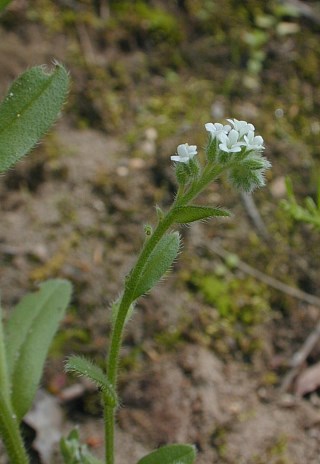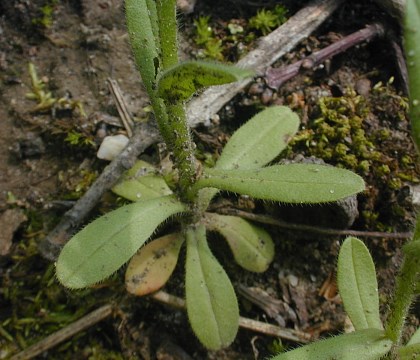Description:
This
wildflower is a winter annual or biennial about ½–1½' tall that
is unbranched or branches occasionally. The stems are light green,
terete or angular, and covered with long white hairs. The alternate
leaves are ½–2" long and about one-third as wide; they are light green,
oblong or oblanceolate, smooth and ciliate along the margins, and
usually hairy on both the upper and lower surfaces. Each leaf has a prominent central vein. The
leaves are mostly sessile against their stems; the lowest leaves taper
to petiole-like bases. The central stem and upper lateral stems (if
present) terminate in elongated racemes of small white flowers about
2-8" long. Each raceme has about 8-24 flowers on a hairy stalk; there
are no bracts alongside the flowers. The flowers bloom toward the apex
of each raceme, where it is typically curled like a scorpion's tail;
the hairy ovoid fruits develop below. Each flower is 1/8" across,
consisting of a white corolla with 5 rounded lobes, a hairy calyx with
5 lanceolate sepals, 5 stamens (inconspicuous), and a pistil. Sometimes
the hairs of the calyx are hooked at their tips. The blooming period
occurs from mid-spring to early summer and lasts about 2 months. The
racemes become longer as their dry fruits (seed capsules) develop;
these fruits have pedicels that are more or less erect. At this stage
of development, the pedicels are a little shorter than their fruits.
Each fruit contains 4 seeds. The root system consists of a taproot and
secondary fibrous roots. This wildflower reproduces by reseeding itself.
prominent central vein. The
leaves are mostly sessile against their stems; the lowest leaves taper
to petiole-like bases. The central stem and upper lateral stems (if
present) terminate in elongated racemes of small white flowers about
2-8" long. Each raceme has about 8-24 flowers on a hairy stalk; there
are no bracts alongside the flowers. The flowers bloom toward the apex
of each raceme, where it is typically curled like a scorpion's tail;
the hairy ovoid fruits develop below. Each flower is 1/8" across,
consisting of a white corolla with 5 rounded lobes, a hairy calyx with
5 lanceolate sepals, 5 stamens (inconspicuous), and a pistil. Sometimes
the hairs of the calyx are hooked at their tips. The blooming period
occurs from mid-spring to early summer and lasts about 2 months. The
racemes become longer as their dry fruits (seed capsules) develop;
these fruits have pedicels that are more or less erect. At this stage
of development, the pedicels are a little shorter than their fruits.
Each fruit contains 4 seeds. The root system consists of a taproot and
secondary fibrous roots. This wildflower reproduces by reseeding itself.
Cultivation:
The preference is full sun to light shade, moist to dry conditions, and
barren soil containing sand, gravel, or clay. Most growth and
development occurs during the spring.
Range & Habitat:
The native Spring Scorpion Grass is occasional to locally common in the
southern
half of Illinois, while in the northern half of the state it is
uncommon or absent (see Distribution
Map). Habitats include upland open woodlands, barren wooded
slopes, areas along woodland paths, sandy savannas, sand prairies,
fields, roadside embankments, and areas along railroads. This little
wildflower occurs in barren areas where there is little ground
vegetation – frequently where there is some history of disturbance.
Occasionally, it is found in damp areas.
Faunal Associations:
Small bees and small butterflies visit the flowers for nectar.
Robertson (1929) observed only two floral visitors: the Halictid bee Augochlorella
striata and the butterfly Pontia protodice
(Checkered White). The flea beetle Longitarsus melanurus
feeds on the foliage of Spring Scorpion Grass and other species in the
Borage family. LeConte's Sparrow and possibly other birds eat the seeds
of this wildflower and the closely related Myosotis
macrosperma (Big-Seeded Scorpion Grass); this was observed at
Tucker's Prairie in Missouri. The hairy fruits can cling to the fur of
mammals and clothing of humans; this helps to distribute the seeds to
new locations.

Photographic
Location:
A wooded slope near Charleston, Illinois.
Comments:
This wildflower has small flowers and is fairly easy to overlook. In
spite of its common name, Spring Scorpion Grass is a member of the
Borage family, rather than the Grass family (Poaceae). This species is
very similar to Myosotis macrosperma (Big-Seeded
Scorpion Grass); sometimes they are considered different varieties of
the same species. According to Mohlenbrock (2002), Spring Scorpion
Grass has fruits with more erect pedicels and smaller seeds than
Big-Fruited Scorpion Grass; in Illinois, the latter is restricted to a
few southern counties. Another similar species is Buglossoides
arvense (Corn Gromwell). Corn Gromwell has leafy bracts
alongside its flowers, while the flowers of Spring Scorpion Grass (and
other Myosotis spp.) lack such bracts. There are
also several Myosotis spp. (Forget-Me-Not species)
from Europe that occasionally escape from cultivation. These introduced
species have blue flowers. Another common name of Myosotis
verna is White Forget-Me-Not.